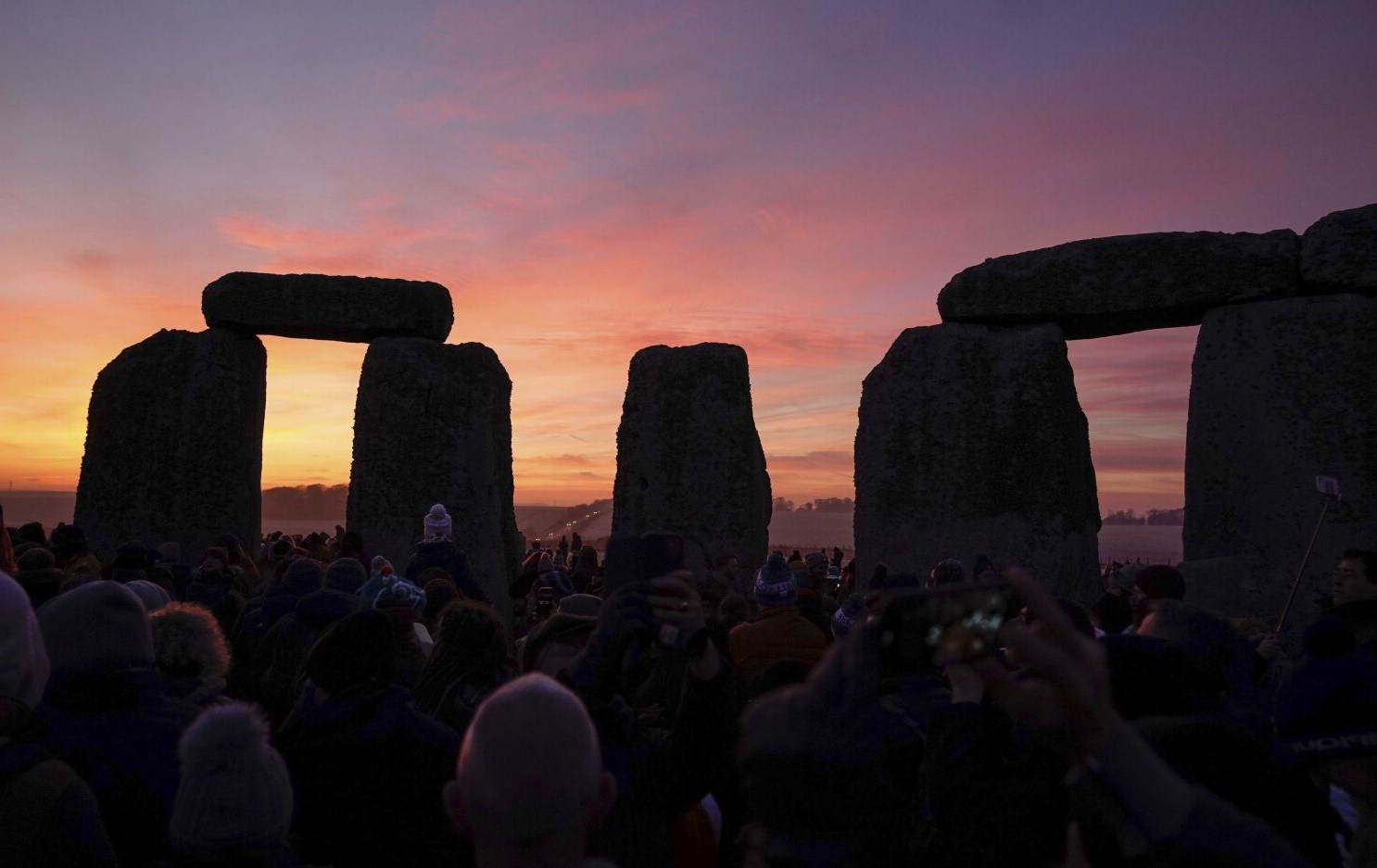Home>Weather and Climate>Understanding The Significance And Meaning Of Solstices


Weather and Climate
Understanding The Significance And Meaning Of Solstices
Published: March 5, 2024
Discover the impact of solstices on weather and climate. Gain a deeper understanding of their significance and meaning in the natural world.
(Many of the links in this article redirect to a specific reviewed product. Your purchase of these products through affiliate links helps to generate commission for Temperatures.com, at no extra cost. Learn more)
Table of Contents
- Introduction
- The History of Solstices
- The Science Behind Solstices
- Cultural and Religious Significance of Solstices
- Modern Celebrations and Observances of Solstices
- The Symbolism of Solstices in Literature and Art
- How Solstices Affect Nature and Agriculture
- The Spiritual and Personal Meaning of Solstices
- Conclusion
Introduction
The solstices, which occur twice a year, mark significant astronomical events that have captivated human civilization for millennia. These celestial occurrences, known as the summer and winter solstices, hold profound cultural, spiritual, and agricultural significance across diverse societies. As we delve into the history, science, and symbolism of solstices, we will uncover the multifaceted layers of meaning embedded within these celestial events.
The solstices, occurring around June 21st and December 21st in the Northern Hemisphere, represent the longest and shortest days of the year, respectively. Conversely, in the Southern Hemisphere, the dates are reversed, with the summer solstice falling in December and the winter solstice in June. These dates are not arbitrary but are intricately linked to the Earth's axial tilt and its orbit around the sun.
The solstices have been revered by ancient civilizations, including the Egyptians, Mayans, and Druids, who constructed monumental structures aligned with the sun's position during these pivotal moments. The alignment of Stonehenge with the summer solstice sunrise and the Mayan pyramid of Chichen Itza with the winter solstice sunset are testaments to the profound cultural and spiritual significance attributed to these celestial events.
As we embark on this exploration of solstices, we will unravel the scientific underpinnings of these phenomena, examining the intricate interplay between the Earth's axial tilt, the sun's rays, and the changing seasons. Furthermore, we will delve into the rich tapestry of cultural and religious traditions associated with solstices, shedding light on the diverse ways in which different societies have celebrated and revered these celestial occurrences.
The solstices are not merely astronomical events; they are deeply intertwined with the rhythms of nature and agriculture. Understanding the impact of solstices on natural phenomena, such as the migration of animals and the growth of crops, provides a holistic perspective on the interconnectedness of celestial events and the terrestrial world.
As we embark on this journey of discovery, we will unravel the layers of symbolism and personal significance that solstices hold for individuals, transcending geographical and cultural boundaries. Through this exploration, we will gain a deeper appreciation for the profound impact of solstices on human consciousness and the natural world.
The History of Solstices
The history of solstices is deeply intertwined with the evolution of human civilization and the quest to comprehend the celestial phenomena that shape our world. Dating back to ancient cultures, the solstices have been revered as pivotal moments in the annual cycle, marking the extremes of daylight and darkness. The significance of these astronomical events is evident in the architectural marvels and cultural practices of early societies.
In ancient Egypt, the alignment of the Great Pyramids with the solstices reflects the profound reverence for these celestial occurrences. The positioning of the pyramids allowed the ancient Egyptians to observe the sun's alignment with the structures during the summer and winter solstices, underscoring the meticulous astronomical knowledge possessed by these early civilizations.
Similarly, the Mayans, renowned for their advanced understanding of astronomy, constructed architectural marvels, such as the pyramid of Chichen Itza, to align with the sun's position during the solstices. The intricate interplay between architecture, astronomy, and cultural significance is a testament to the profound impact of solstices on ancient societies.
In Europe, the solstices held immense cultural and religious significance for the Druids, who celebrated the summer solstice as the festival of Litha, marking the peak of the sun's power. The alignment of Stonehenge with the summer solstice sunrise exemplifies the spiritual and cultural reverence for these celestial events, underscoring the enduring legacy of solstices in shaping human traditions.
The history of solstices is not confined to specific geographical regions but resonates across diverse cultures and civilizations. From the Inca Empire in South America to the indigenous tribes of North America, the solstices have been woven into the fabric of cultural practices, rituals, and mythologies, reflecting the universal fascination with these astronomical milestones.
As we traverse through the annals of history, the enduring legacy of solstices becomes apparent, transcending temporal and geographical boundaries. The profound impact of these celestial events on the cultural, spiritual, and scientific realms underscores their timeless significance in shaping human consciousness and societal traditions.
The history of solstices serves as a testament to humanity's enduring quest to comprehend and honor the celestial forces that govern our existence, weaving a rich tapestry of cultural heritage and astronomical wisdom that continues to resonate in the modern era.
The Science Behind Solstices
The science behind solstices is rooted in the Earth's axial tilt and its orbit around the sun. The axial tilt, approximately 23.5 degrees relative to the plane of its orbit, is the fundamental factor driving the occurrence of solstices. As the Earth orbits the sun, this tilt causes the sun's rays to strike different latitudes with varying intensity throughout the year, giving rise to the changing seasons and the solstices.
During the summer solstice in the Northern Hemisphere, which occurs around June 21st, the North Pole is tilted towards the sun, resulting in the longest day of the year and the shortest night. Conversely, during the winter solstice, around December 21st, the North Pole is tilted away from the sun, leading to the shortest day and the longest night. In the Southern Hemisphere, the dates of the solstices are reversed, with the summer solstice occurring in December and the winter solstice in June.
The precise timing of the solstices is determined by the Earth's position in its orbit, specifically when it reaches the point of maximum axial tilt towards or away from the sun. This astronomical phenomenon has profound implications for the distribution of solar energy across the planet, influencing climate patterns, agricultural cycles, and the behavior of flora and fauna.
From a scientific perspective, the solstices mark key junctures in the Earth's annual journey around the sun, signifying the extremes of daylight and darkness experienced at different latitudes. The tilt of the Earth's axis, coupled with its orbital motion, engenders the cyclical nature of the solstices, shaping the ebb and flow of seasons and the intricate dance of celestial mechanics.
Understanding the science behind solstices illuminates the intricate interplay between astronomical phenomena and terrestrial experiences, underscoring the profound impact of celestial events on the rhythms of nature and human societies. This scientific insight enriches our appreciation of the solstices as pivotal moments in the cosmic symphony that governs our planet's journey through the solar system.
In essence, the science behind solstices unveils the celestial choreography that orchestrates the changing seasons, the lengthening and shortening of days, and the timeless rhythm of the natural world, offering a glimpse into the harmonious interconnection between the cosmos and the Earth.
Cultural and Religious Significance of Solstices
The solstices hold profound cultural and religious significance across diverse societies, permeating the fabric of human traditions with their celestial resonance. From ancient civilizations to contemporary cultures, the solstices have been revered as sacred moments marking the rhythms of the Earth and the cosmos.
In many indigenous cultures, the solstices are imbued with spiritual significance, symbolizing the balance between light and darkness, life and death, and the cyclical nature of existence. These celestial events often coincide with traditional ceremonies, rituals, and festivals that honor the interconnectedness of humanity with the natural world. For example, among the Native American tribes, the solstices are commemorated through ceremonial dances, storytelling, and communal gatherings that reaffirm the enduring bond between the people and the land.
In the realm of religious observance, the solstices have been integrated into the sacred calendars of various faith traditions, serving as pivotal moments for worship, reflection, and renewal. In paganism and Wiccan practices, the summer and winter solstices are celebrated as Sabbats, marking the zenith of solar power and the rebirth of light, respectively. These celebrations are steeped in symbolism, with rituals honoring the sun, fertility, and the bountiful harvests that sustain life.
Moreover, the solstices have left an indelible mark on the tapestry of world religions, influencing the timing of religious festivals and the construction of sacred sites. In Christianity, the celebration of Christmas, commemorating the birth of Jesus Christ, aligns with the winter solstice, intertwining the Christian narrative with the ancient symbolism of light emerging from darkness. Similarly, in Hinduism, the festival of Makar Sankranti marks the transition of the sun into the Capricorn zodiac sign, coinciding with the winter solstice and symbolizing the commencement of longer days.
The cultural and religious significance of solstices transcends geographical and temporal boundaries, weaving a rich tapestry of traditions, beliefs, and practices that honor the celestial dance of light and shadow. These celestial milestones serve as poignant reminders of the enduring connection between humanity, the cosmos, and the eternal rhythms of nature.
Modern Celebrations and Observances of Solstices
In the modern era, the solstices continue to be celebrated and observed in diverse and vibrant ways, reflecting the enduring resonance of these celestial events in contemporary society. From lively festivals to introspective gatherings, the solstices serve as occasions for communal revelry, spiritual reflection, and ecological awareness.
One of the most iconic modern celebrations of the summer solstice is the annual gathering at Stonehenge in England. Thousands of people from various backgrounds congregate at this ancient site to witness the sunrise aligning with the Heel Stone, marking the onset of the longest day of the year. The atmosphere is imbued with a sense of camaraderie and wonder as revelers welcome the sun's ascent with music, dance, and a spirit of collective jubilation.
Similarly, the winter solstice is commemorated through a myriad of contemporary observances that honor the return of light amidst the darkness of the season. In Scandinavian countries, the tradition of Yule, with its roots in ancient Norse customs, has been rekindled as a festive celebration of the winter solstice. This modern interpretation of Yule encompasses feasting, storytelling, and the lighting of candles to symbolize the triumph of light over darkness.
Beyond these large-scale gatherings, modern celebrations of the solstices encompass a spectrum of activities that resonate with the ethos of the times. Yoga retreats, meditation workshops, and nature walks are organized to honor the solstices, fostering a deeper connection with the natural world and the cosmic rhythms that govern our lives. These contemplative gatherings provide individuals with an opportunity to attune themselves to the shifting energies of the Earth and the sun, fostering a sense of inner harmony and spiritual renewal.
Moreover, environmental organizations and sustainability advocates have embraced the solstices as occasions to raise awareness about ecological stewardship and the interconnectedness of all life. Through tree-planting initiatives, renewable energy campaigns, and educational outreach programs, the solstices serve as catalysts for promoting environmental consciousness and fostering a deeper appreciation for the Earth's delicate balance.
In essence, the modern celebrations and observances of the solstices reflect a tapestry of cultural, spiritual, and ecological expressions that honor the enduring significance of these celestial events. As humanity continues to evolve, the solstices serve as timeless reminders of our intrinsic connection to the cosmos and the rhythms of nature, inspiring a collective reverence for the celestial dance of light and shadow.
Read more: Understanding The Climate Of Mars
The Symbolism of Solstices in Literature and Art
The solstices, with their profound celestial significance, have inspired a rich tapestry of symbolism in literature and art, serving as evocative motifs that encapsulate the eternal dance of light and darkness, life and renewal. In literature, the solstices often serve as powerful metaphors, embodying themes of transformation, rebirth, and the cyclical nature of existence. Writers and poets have woven the imagery of solstices into their works, infusing them with layers of meaning that resonate with readers across cultures and generations.
In art, the solstices have been depicted in diverse forms, from ancient cave paintings to contemporary masterpieces, capturing the essence of these celestial events through visual expression. The interplay of light and shadow, the juxtaposition of warmth and cold, and the symbolism of the sun's ascent and descent during the solstices have provided artists with a rich palette of inspiration. From vibrant solstice festivals to introspective portrayals of the changing seasons, art has served as a timeless conduit for conveying the symbolism of solstices.
In literature, the summer solstice often symbolizes vitality, abundance, and the zenith of life's energies. It is portrayed as a time of jubilation, growth, and the flourishing of the natural world. Conversely, the winter solstice embodies themes of introspection, resilience, and the promise of renewal amidst the darkness. Writers have skillfully utilized the symbolism of solstices to evoke profound emotional landscapes, infusing their narratives with the timeless rhythms of the Earth and the cosmos.
In art, the symbolism of solstices is manifested through a myriad of visual representations, ranging from ancient mythological depictions to contemporary abstract interpretations. The solstices have been portrayed as celestial dramas, with the sun taking center stage amidst the backdrop of the changing seasons. Artists have harnessed the symbolism of solstices to convey themes of hope, transformation, and the enduring cycle of life, encapsulating the essence of these celestial events in their creations.
The symbolism of solstices in literature and art transcends linguistic and cultural barriers, resonating with individuals on a profound and universal level. Through the power of storytelling and visual expression, the solstices have become enduring symbols of the human experience, encapsulating the timeless themes of light, darkness, and the eternal dance of nature. In literature and art, the symbolism of solstices continues to inspire and captivate, inviting audiences to contemplate the profound mysteries of the cosmos and the enduring symbolism of these celestial milestones.
How Solstices Affect Nature and Agriculture
The solstices exert a profound influence on the rhythms of nature and the agricultural cycles, shaping the behavior of flora and fauna and impacting the cultivation of crops. These celestial events mark pivotal junctures in the annual cycle, heralding the transition of seasons and the fluctuation of daylight and darkness, which in turn engender a cascade of effects on the natural world.
During the summer solstice, the Northern Hemisphere experiences the longest day of the year, accompanied by an abundance of sunlight and warmth. This extended period of daylight serves as a catalyst for the proliferation of plant life, facilitating photosynthesis and the rapid growth of vegetation. The increased solar energy during this time fosters the flourishing of ecosystems, leading to the blooming of flowers, the emergence of new foliage, and the heightened activity of pollinators and wildlife.
Conversely, the winter solstice, with its shorter daylight hours and prolonged darkness, initiates a period of dormancy and conservation in nature. Many plants enter a phase of dormancy, shedding leaves and conserving energy to endure the harsh conditions of winter. Wildlife adapts to the scarcity of daylight by adjusting their behaviors, such as hibernation and migration, in response to the changing photoperiod.
In the realm of agriculture, the solstices play a pivotal role in determining the timing of planting, harvesting, and agricultural practices. The summer solstice marks the peak of solar energy, providing an opportune period for sowing crops and nurturing their growth. Farmers leverage the extended daylight to maximize the photosynthetic potential of crops, fostering robust yields and bountiful harvests.
Conversely, the winter solstice signals a period of introspection and planning for agricultural communities. As daylight diminishes, farmers prepare for the onset of winter, ensuring the preservation of crops and the maintenance of agricultural infrastructure. The winter solstice serves as a time for reflection and strategic decision-making, laying the groundwork for the upcoming agricultural season.
The impact of solstices on nature and agriculture underscores the intricate interplay between celestial events and terrestrial ecosystems. The cyclical rhythms of light and darkness, warmth and cold, profoundly influence the behavior of plants, animals, and agricultural endeavors, shaping the intricate tapestry of life on Earth. Understanding the influence of solstices on nature and agriculture provides a holistic perspective on the interconnectedness of celestial phenomena and the sustenance of life on our planet.
The Spiritual and Personal Meaning of Solstices
The solstices hold profound spiritual and personal significance for individuals across cultures, transcending geographical boundaries to resonate with the depths of human consciousness. At a spiritual level, the solstices serve as potent reminders of the eternal dance between light and darkness, symbolizing the interplay of opposing forces within the human psyche. The summer solstice, with its zenith of solar power and abundance of light, embodies themes of vitality, growth, and the awakening of inner potential. It is a time for embracing the fullness of life, harnessing the energy of the sun to illuminate the path of personal growth and self-realization.
Conversely, the winter solstice, shrouded in the cloak of darkness and the promise of renewal, invites introspection, inner healing, and the cultivation of resilience. It symbolizes the journey into the depths of the soul, where dormant seeds of wisdom and transformation await the nurturing touch of inner light. The winter solstice beckons individuals to kindle the flame of hope amidst the darkness, embracing the promise of renewal and the emergence of new beginnings.
On a personal level, the solstices offer individuals an opportunity for introspection, renewal, and alignment with the natural rhythms of the Earth. Many people use the solstices as occasions for personal rituals, meditation, and setting intentions for the coming season. Whether through solitary contemplation in nature or communal gatherings with like-minded individuals, the solstices provide a sacred space for individuals to attune themselves to the cosmic energies and seek inner harmony.
Moreover, the solstices inspire a sense of interconnectedness with the Earth and the cosmos, fostering a deep appreciation for the cyclical nature of existence. Individuals often find solace and inspiration in the timeless symbolism of the solstices, drawing strength from the enduring dance of light and darkness that mirrors the ebb and flow of their own lives.
In essence, the spiritual and personal meaning of solstices transcends mere astronomical events, permeating the human experience with profound symbolism and transformative potential. As individuals engage with the solstices on a spiritual and personal level, they are invited to embrace the eternal rhythms of nature, kindle the flame of inner illumination, and embark on a journey of self-discovery and renewal.
Conclusion
In conclusion, the solstices stand as timeless celestial milestones that have woven a rich tapestry of cultural, spiritual, and agricultural significance throughout human history. From the architectural marvels of ancient civilizations to the contemporary celebrations and personal reflections, the solstices continue to captivate the human imagination and inspire a profound reverence for the cosmic dance of light and darkness.
The exploration of the history of solstices unveils the enduring legacy of these celestial events, transcending temporal and geographical boundaries to shape the cultural and spiritual practices of diverse societies. The alignment of ancient monuments with the solstices stands as a testament to humanity's enduring quest to comprehend and honor the celestial forces that govern our existence.
Furthermore, the scientific underpinnings of solstices shed light on the intricate interplay between the Earth's axial tilt, its orbit around the sun, and the changing seasons. Understanding the science behind solstices enriches our appreciation of these phenomena as pivotal moments in the cosmic symphony that governs our planet's journey through the solar system.
The cultural and religious significance of solstices permeates the fabric of human traditions, serving as sacred moments that honor the interconnectedness of humanity with the natural world. From indigenous ceremonies to modern observances, the solstices continue to inspire communal revelry, spiritual reflection, and ecological awareness.
Moreover, the symbolism of solstices in literature and art resonates with individuals on a profound and universal level, encapsulating the timeless themes of light, darkness, and the eternal dance of nature. The solstices serve as enduring symbols of the human experience, inviting audiences to contemplate the profound mysteries of the cosmos and the enduring symbolism of these celestial milestones.
In essence, the solstices embody the eternal rhythms of nature, inviting individuals to embrace the cyclical nature of existence, kindle the flame of inner illumination, and embark on a journey of self-discovery and renewal. As we continue to traverse the cosmic symphony of the Earth's journey around the sun, the solstices stand as poignant reminders of our intrinsic connection to the cosmos and the enduring rhythms of nature.














